Ants are one of the most frequently encountered pests both indoors and outdoors. Although ants are not directly harmful to humans, they can be quite a nuisance, especially if a large colony has established nesting sites in your household.
What are the types of ants that invade homes? The most commonly encountered household ants include Argentine ants, carpenter ants, crazy ants, fire ants, ghost ants, grease ants, odorous house ants, pavement ants, Pharaoh ants, and rover ants. Different ant species require different treatments; thus, proper identification is critical.
Ant infestation could be annoying, but knowing which ant species you are dealing with would make it easier to find ways to get rid of them successfully.
Table of Contents
Basic Anatomy of Worker Ants
Foraging worker ants are commonly seen scurrying around households since, as their name implies, they perform all the work to sustain their colonies. Thus, familiarizing oneself with the basic body parts of worker ants is the first step to identifying their species.
As with other insects, ants have three distinct body regions: head, thorax, and abdomen.
Ant Head
Ants have a pair of compound eyes located on each side of their heads. These compound eyes provide a large viewing angle that allows ants to see in multiple directions at once. They also have a pair of elbowed antennae attached to their heads, enabling them to communicate and detect smell, touch, and taste.
An ant’s head also contains the mandibles (mouthparts), which they use to cut, bite, and carry food items back to their nesting sites.
The size and the shape of ant heads provide several clues on their food preference and lifestyle, and most importantly, the species they belong to.
Thorax
Thorax is the middle segment of an ant’s body. Attached to it are three pairs of legs. The thorax connects to the abdomen with a constricted area called the petiole. An ant’s petiole can have either one or two nodes, depending on the ant species.
Abdomen
The largest part of an ant’s body is the abdomen, also called a gaster. Stinger’s presence or absence at the tip of the ant’s gaster, as well as its shape and color, distinguishes one ant species from another.
Different Types of Ants in Home
Although challenging, ant identification is the most critical step towards addressing the problem of ant infestation. Since more than one species can invade your home, knowing what they are and how they differ from one another would enable you to execute proper control and prevention measures.
Besides the characteristics of their body parts, another important feature that could aid in identifying ant species is the size of the worker ants. Worker ants could have uniform sizes (monomorphic) or variable sizes (polymorphic).
Argentine Ants
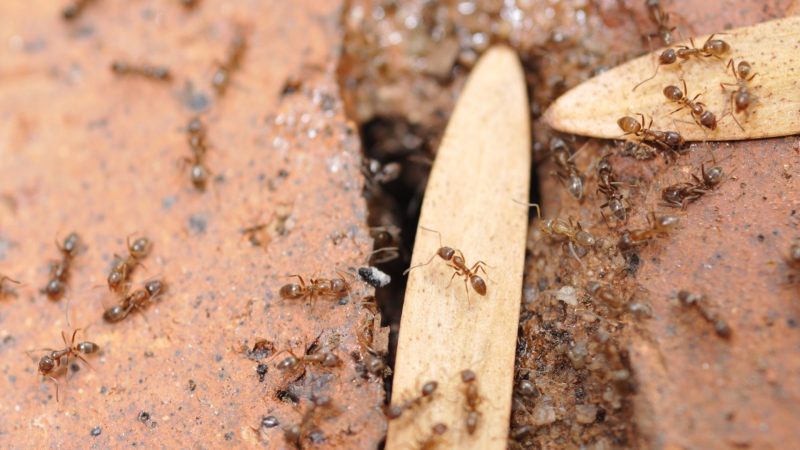
Identifying Characteristics
Argentine ants (Linepithema humile) have monomorphic workers, about 1/8 in (3 mm) in length, with colors ranging from light brown to dark brown.
Food Preference
Although these ants would practically feed on any food, they are more fond of sweets such as honeydew produced by aphids and other organic matter. Often, they would also search for fats and protein such as insects and eggs. Argentine ants are also known to prey on vulnerable animals.
Nesting Site
Argentine ants are native to North Argentina but are now known to have adapted to the United States, especially areas with a mild climate. Due to their aggressive behavior, argentine ants can establish large colonies in households as they take down colonies of other ant species.
Their colonies are mostly found outdoors, especially in moist areas (under logs, stones, concrete slabs, debris, and mulch), but would find their way indoors during winter.
Control
Eliminating colonies of Argentine ants could be quite difficult since they often occur in huge numbers. Careful inspection should be carried out to locate nests both indoors and outdoors. Once located, it is recommended to place bait stations outdoors, as indoor applications may invite more ants into your home.
Argentine ants are particularly attracted to sweets; thus, sweet sugar baits such as boric acid may be used to control their population. On the other hand, protein baits containing fipronil or hydramethylnon may be used in particular during spring or late summer.
Carpenter Ants
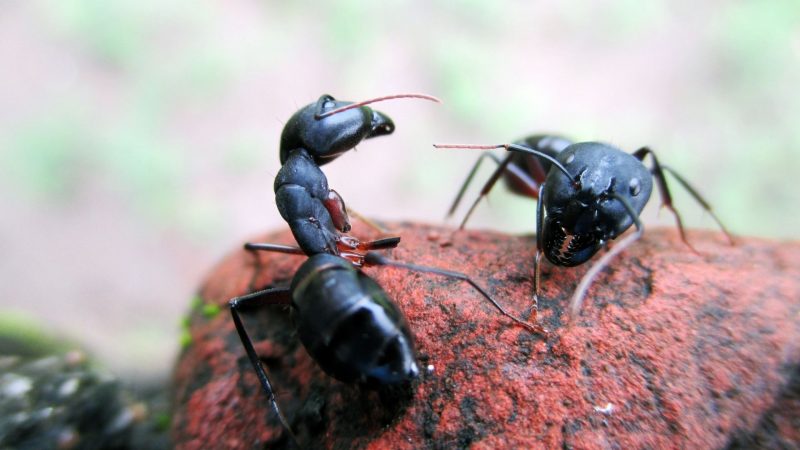
Identifying Characteristics
Carpenter ants (Camponotus pennsylvanicus) have polymorphic workers about 1/4 to 1/2 in (7 to 13 mm) long, which may appear in black or a combination of dark brown or dark red colors. When viewed from the side, carpenter ants seem to have an evenly rounded thorax.
Food Preference
Outdoors, these ants feed on insects but mostly prefer sweets such as honeydew. When found indoors, carpenter ants would feed on meat and sweet food such as sugar, syrup, honey, and jelly.
Nesting Site
Carpenter ants can be found throughout the United States but are commonly found in areas with a humid climate. These ants build their nests both indoors and outdoors, usually in moist, wooded areas.
Indoors, these ants would nest in hollow wooden doors, cracks around windows, attic beams, damaged wooden cabinets, and other damp and wood structures around the house. Outdoors, colonies can be found in dead trees, rotting wood or trees, and in hollow branches of trees.
Carpenter ants are known to establish satellite colonies. They cause severe damage when invading houses as they create tunnels for navigation and expansion of their nests as their number increases.
Control
The most effective control measure to prevent infestation of carpenter ants is to remove potential nesting sites (moist, wooded areas) indoors and outdoors. Since these ants seek out moist areas, repairing leaks and drainage problems would also help prevent infestation.
Following trails and finding signs of sawdust accumulation may aid in locating satellite nests. In cases where satellite colonies could not be found, sweet baits may be used.
Often, the infestation of carpenter ants is addressed by destroying the primary colony usually found outdoors. Indoors, ant dust may be applied in cracks and crevices, wall voids, around doors and windows, and in other areas where ant activities are present.
For extensive infestation that might require drilling, the assistance of pest control professionals may be sought out.
Crazy Ants
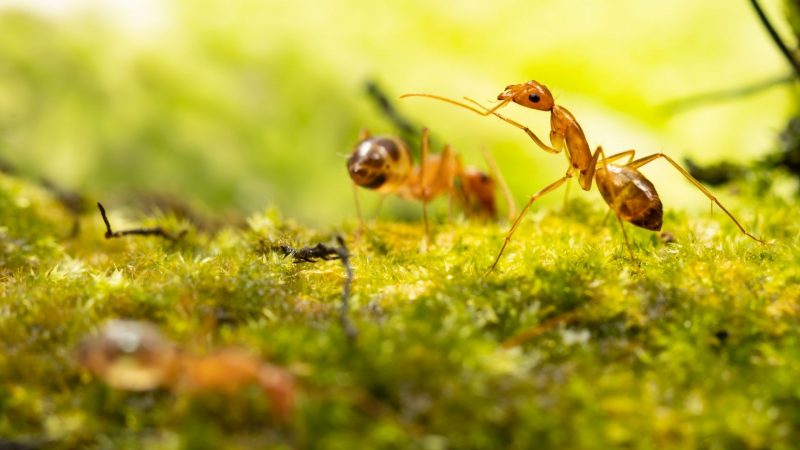
Identifying Characteristics
Crazy ants (Paratrechina longicornis) have monomorphic workers about 1/16 to 1/8 in (2 to 3.5 mm) long. The body of a crazy ant has grayish hairs and dark brown to black gaster. A single node petiole connects its gaster to its thorax.
These ants are known for their erratic and rapid movement, as though they are lost and confused. Moreover, unlike other ants, crazy ants have a habit of not following trails.
Food Preference
Crazy ants are omnivorous. Outdoors, these ants would feed on living or dead insects (mealybugs and scale insects), sweets (honeydew), seeds (lettuce and tobacco), and fruits. Inside, crazy ants would feed on sweets but prefer a protein diet during summer.
Nesting Site
Crazy ants can adapt to various environments. They can be found in several indoor and outdoor locations, whether in dry or humid areas.
These ants invade homes after rainfall when honeydews are unavailable and would build nests in the soil of potted plants and under floors or carpets. Outside, they nest in soil and cavities of plants and trees.
Locating the nests of crazy ants would be challenging as these ants typically establish nests far from their forage areas.
Control
Nests of crazy ants can be located by following their trails or by using ant baits. Once located, ant dust may be used for perimeter treatment of suspected nesting sites both indoors and outdoors.
Red Imported Fire Ants
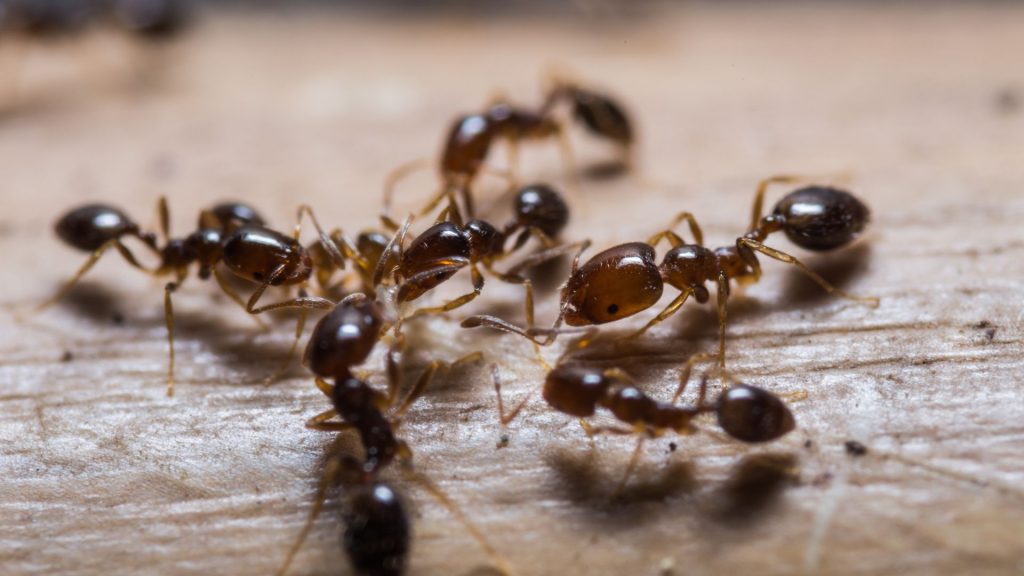
Identifying Characteristics
Red imported fire ants (Solenopsis invicta) have polymorphic workers about 1/16 to 1/4 in (2 to 7 mm) long. These ants have a reddish-brown body color with a darker abdomen. A stinger is present at the tip of its abdomen. The abdomen connects to the thorax through a two-node petiole.
Food Preference
Red imported fire ants feed on plant and animal matter and honeydew. Indoors, worker ants would forage for sweets, high-protein foods, and fats.
Nesting Site
Mounds of red imported fire ants are commonly found outdoors, with diameters usually smaller than 18 in (46 cm). Although these ants almost always nest outdoors, they tend to invade homes and buildings in late summer to search for food and water and eventually establish nests under carpets, wall voids, and crawl spaces.
These ants are also known to be very aggressive. When disturbed, they will emerge from their mound and sting the intruders repeatedly.
Control
Infestation of red imported fire ants can be solved by treating individual mounds with insecticide.
In using individual mound treatments, the inspection of ant activities outdoors should be performed diligently in order to locate colonies. Once located, mound drenching, dust application, and ant baits can be used to eliminate ant colonies. Of these methods, using ant baits is found to be the most effective.
Ghost Ants
Identifying Characteristics
Ghost ants (Tapinoma melanocephalum) have extremely small monomorphic workers, which are about 1/16 in (2 mm) in length.
They are characterized by their dark head and thorax and pale gaster and legs, which gives them a ghost-like appearance. Ghost ants do not possess a stinger, and the thorax lacks spines.
Ghost ant workers are known to have a habit of secreting an odor similar to that of rotten coconut.
Food Preference
Although these ants will feed on any household food, they have shown a preference for sweet food items such as sugar, cake, and syrup. Outside, ghost ants will feed on live and dead insects as well as honeydew.
Nesting Site
Ghost ants can be found in areas with warm temperatures. Outside, they would build nests under stones and in cavities of trees and shrubs. Inside, these ants would nest in cracks and crevices. They are often found in spaces between cabinets, wall voids, and potted plants.
They also have high moisture needs. Thus, foragers are commonly seen in kitchens and bathrooms’ sinks, counters, and floors.
Control
Since ghost ants often nest in potted plants, an infestation could be prevented by removing plants that can attract ants. Likewise, the presence of aphids should also be addressed as they are the main source of honeydew, which ghost ants feed on.
Ant baits can be used to eliminate colonies. To prevent these ants from returning, ant dust and sprays can be used as barriers on possible entry points.
Grease Ants
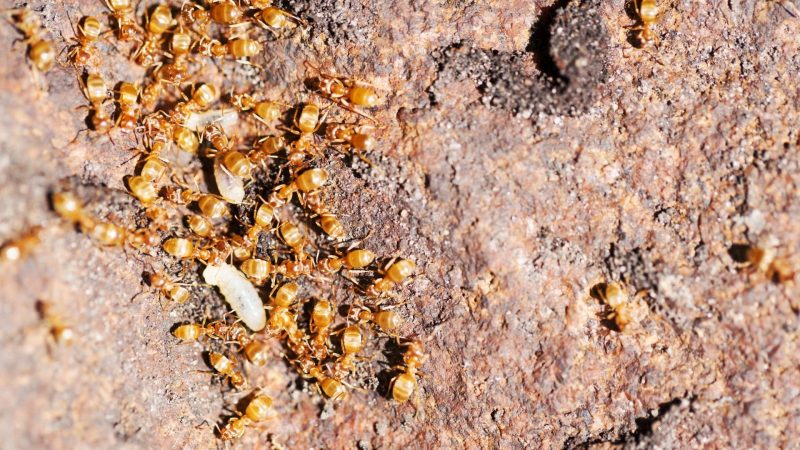
Identifying Characteristics
Grease ants (Solenopsis molesta), also called thief ants, are among the smallest known household ants about 1/16 in (2 mm) long. They have monomorphic workers with pale yellow to light or dark brown color. Their thorax lack spines and a small stinger may be visible at the tip of the abdomen.
Food Preference
When nesting outdoors, grease ants feed on insects, honeydew, and seeds, including germinating seeds. Indoors, workers would forage for greasy and high-protein food items such as meat, nuts, peanut butter, animal fats, and vegetable oil but will also feed on sweets.
Their small size allows them to enter packaged foods and containers easily.
Nesting Site
Thief ants build their nests indoors and outdoors close to nests of other ant species and steal their food to feed their own colony. Outside, these ants would nest in soil, rotten wood, and under rocks or logs. Inside, they would nest indoors in small spaces, such as under kitchen counters and in cracks and voids of walls and cabinets.
Control
Outdoors, perimeter treatment may be employed in treating thief ants since locating nests could be quite tedious due to their small sizes.
For the same reason, preventing the entry of thief ants in homes and buildings should be prioritized. As such, cracks and crevices should be sealed, and good sanitation should be practiced to make your home uninviting.
When thief ants invade your home, use ant baits to eliminate the colonies.
Odorous House Ants
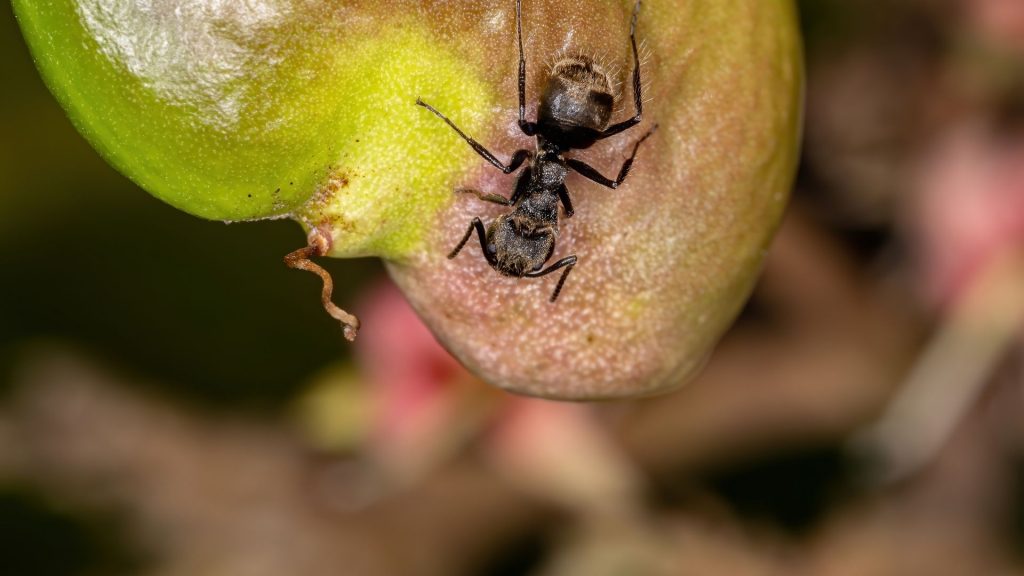
Identifying Characteristics
Odorous house ants (Tapinoma sessile) have monomorphic workers about 1/8 in (3.5 mm) long, with uniform brown to black color. The abdomen of an odorous ant lacks a stinger, and the thorax is uneven in shape.
Like ghost ants, odorous house ants also emit an unpleasant smell comparable to rotten coconut when crushed.
Food Preference
These ants feed on both living and dead insects and honeydew (from aphids and mealybugs) outdoors, whereas they would search for sweets and meat indoors.
Nesting Site
Odorous house ants are native to the US. They are known to build nests in a variety of locations, both indoors and outdoors.
Indoors, odorous house ants nest in cracks and voids of walls, small openings around sinks and kitchen cupboards, and near heat or moisture sources such as water pipes and heaters.
Outdoors, colonies of odorous ants would be found under objects such as stones and debris.
These ant species are most likely to enter buildings to search for food as their colony grows and when conditions become unfavorable (drought or flood).
Control
Odorous ants are known to establish colonies in various locations. Thus, treatment would depend on the location of nests. Drench treatments are most effective when treating outdoor nests. On the other hand, indoor nests may be treated using ant baits or ant dust, especially for nests located in wall voids and other small spaces.
Pavement Ants

Identifying Characteristics
Pavement ants (Tetramorium caespitum) have monomorphic workers about 1/8 in (3.5 mm) in length. Their color ranges from dark brown to black, while their legs and antennae are paler. Pavement ants are characterized by parallel lines (grooves) in their head and thorax. A stinger can be found at the tip of the gaster.
Food Preference
Pavement ants are known to be generalists or opportunistic feeders. They feed on various household foods such as meats, nuts, sweets (sugar and syrup). Outdoors, their diet includes insects (living or dead), seeds, and honeydew from aphids. Pavement ants would also raid pet food both indoors and outdoors.
Nesting Site
Pavement ants are named as such because they prefer nesting in or under cracks in pavements such as sidewalks and driveways. Occasionally, these ants would nest indoors in areas around heat sources, especially during winter.
Control
Pavement ants commonly nest outdoors under cracks in pavements. Baiting is highly recommended as this method eliminates the entire colony, especially when nests are difficult to locate.
Ant sprays may be used as a form of perimeter treatment to prevent these ants from invading your home.
Pharaoh Ants
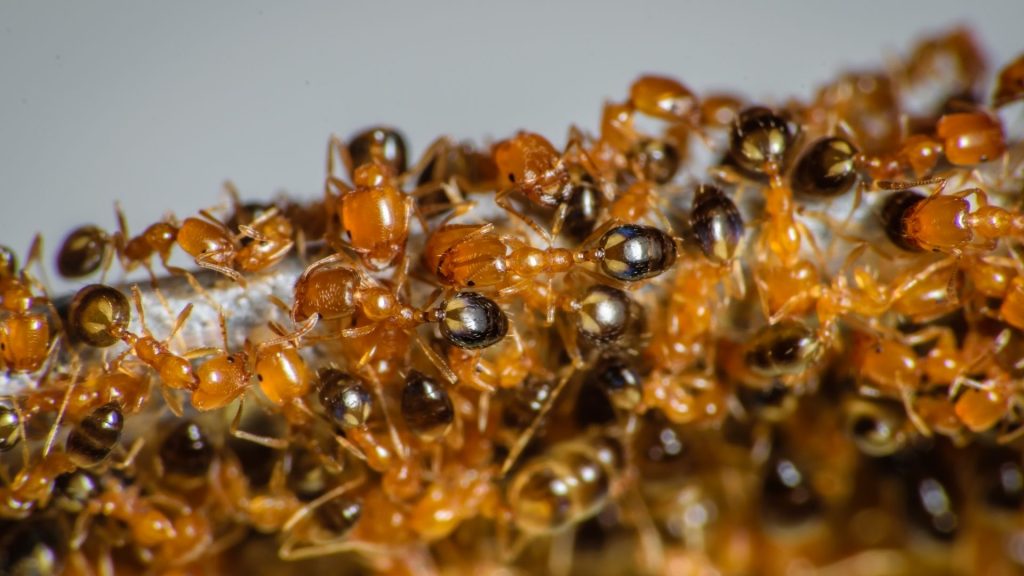
Identifying Characteristics
Pharaoh ants (Monomorium pharaonis) have very small monomorphic workers about 1/16 to 1/12 in (2.0 to 2.1 mm) long. These ants have pale yellow or light brown to red body color with dark shading on the gaster. A stinger is present at the tip of its gaster but is rarely visible.
Food Preference
Pharaoh ants would consume a wide variety of food. They would eat sweet, fatty, or oily foods and other household items that other ants would not be attracted to, such as soap and toothpaste. Outside, these ants would feed on dead insects.
Nesting Site
Pharaoh ants typically nest indoors in particular areas with dark and narrow spaces such as between sheets of stationary, layers of bed linen and clothes, in appliances, electrical boxes, or even piles of trash.
They are often found around kitchens and bathrooms or near water sources.
Control
Pharaoh ant infestation is best treated using ant baits, especially since these ants nest in narrow spaces, which are often inaccessible. Treatment, however, would include various indoor locations. Thus, suitable ant baits should be used depending on the suspected location of colonies.
For extensive infestation, professional help may be sought.
Rover Ants
Identifying Characteristics
Rover Ant, Brachymyrmex sp. are commonly found in soil, trunks of trees, and decaying wood. These ants would invade homes and buildings for food, preferably sweets. Their activities are mostly detected in areas with abundant moisture, such as bathrooms, plumbing, or structural leaks.
Food Preference
Outdoors, rover ants would consume honeydew. Thus, their colonies are commonly associated with sapsuckers such as mealybugs and aphids. They are also known to visit extrafloral nectaries for nectar. Indoors, these ants would also feed on sweets.
Nesting Site
Rover ants are commonly found in soil, trunks of trees, and decaying wood. These ants would invade homes and buildings for food, preferably sweets. Their activities are mostly detected in areas with abundant moisture such as bathrooms, plumbing, or structural leaks.
Control
Control of rover ants is best addressed through prevention measures. Since these ants mainly feed on honeydew, the population of mealybugs and aphids should be managed. Moreover, using baits may also be effective especially sugar-based ant baits.
Outdoors, perimeter treatments may also be employed to prevent these ants from invading homes and buildings.
Do Heavy Rains Cause Ants in Your Home?
Ant invasion is indeed associated with weather. Most ants build their nests in soils, in areas close to the soil, or underneath objects. Thus, ants tend to invade homes, especially after heavy rainfall when the ground becomes excessively saturated.
The same behavior may be observed when ants invade homes when the weather is too hot, causing food and water sources to dry up.
Summary
Different ant species may invade homes and buildings. Some known household ants include Argentine ants, carpenter ants, crazy ants, fire ants, ghost ants, grease ants, odorous house ants, pavement ants, Pharaoh ants, and rover ants. Identification of ant species is critical in order to employ proper treatment methods.
Depending on species, ants would exhibit varying nesting behavior and food preference. Gaining familiarity with these characteristics would aid in locating colonies and implementing control tactics to address ant infestation and prevent reinfestation.
List of Sources
What to Do About Household Ants
Tapinoma melanocephalum (Ghost Ant)
Identification of Structure-Invading Ants in Nebraska
News Release: Household Ant Invasions Are Determined by Weather, Not Pesticide Use, New Study Finds